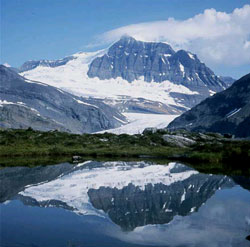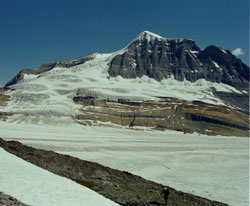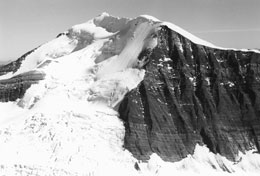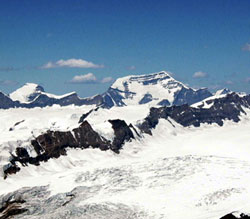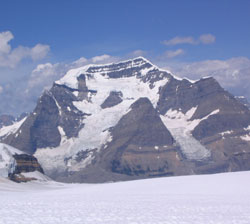
Looking north to Mount Clemenceau from the neve of the Clemenceau icefield (courtesy John Duerden)
Mount Clemenceau
- 3658 m (12,002ft)
- First Ascent
- Naming History
Located at the head of Clemenceau Creek in the Clemenceau Icefield
Province: BC
Headwater: Columbia
Ascent Party: D.B. Durand, H.S. Hall, W.D. Harris, H.B. De V. Schwab
Named by: Interprovincial Boundary Survey
Named for: Clemenceau, Georges (An important French politician, Clemenceau served as Premier of France from 1906 - 1909 and again from 1917 - 1919.)
"This icy giant is king of the remote Clemenceau Icefield. Although one of the four 12,000 foot summits of the Canadian Rockies it is rarely climbed" -courtesy Chic Scott During his 1892 visit to the Rockies, Arthur Coleman left his packhorses and "tramped" up the Chaba River in search of the elusive Mount Brow and Mount Hooker. Following the third night out the party climbed made an unsuccessful attempt to climb the mountain that they named Fortress Mountain and were the first to see Fortress Lake which they named after the mountain. The following day they reached a high point to the west of Fortress Mountain and saw a, "white pyramid beyond the glacier to the south." On August 23rd they set out for the Pyramid Mountain (now known as Mount Clemenceau). They encountered difficulties with crevasses, weather and visibility, turning back after reaching 9900 feet. The following day they retraced their steps and reached the summit of Misty Mountain (now known as Brouillard Mountain). They then determined that the mountain they had been referring to as Pyramid Mountain did not join the mountain that they were on. "Its top was probably two thousand feet above us and three or four miles away, and it seemed very isolated, so that we had to forego any attempt at climbing it, since our supplies were low... Thus far this splendid peak has never been approached by a white man except on our climb of Misty Mountain." Four years later >Robert L. Barrett and Walter Wilcox were on Fortress Mountain, Barrett reaching the summit. In "The Rockies of Canada," Wilcox wrote of being most impressed by a mountain that must have been Clemenceau: "The clouds opened a moment and disclosed what appeared to be by far the highest and finest peak that I had seen on the entire journey, ten miles to the south-west. It was a wedge-shaped peak, rising from a very long and precipitous wall of rock, which seemed to be over ten thousand feet high." Born in Vendée, France in 1841, Georges Clemenceau grew up with strong republican views. He began involved with a publication that was seized by the police and Clemenceau spent 73 days in prison. After finishing his medical studies he went to live in the United States because he was impressed by the political freedom enjoyed by the people there. Clemenceau returned home in 1869 and became a doctor. In February, 1871, Clemenceau was elected as a Radical Republican deputy in the National Assembly. After being re-elected to the National Assembly in 1876, Clemenceau emerged as the leader of the Radical-Republicans. As a result of his aggressive debating style, Clemenceau was given the nickname, 'The Tiger'. In 1902 Clemenceau became a senator and four years later was appointed minister of home affairs. Seven months later he became France's prime minister. His period in office was marked by his hostility to socialists and trade unionists. On the outbreak of the First World War Clemenceau refused office and became an outspoken opponent of Joseph Joffre, chief of general staff in the French Army. Clemenceau also accused the interior minister, Louis Malvy, of being a pacifist when it became known that he favoured a negotiated peace. THE PYRAMIDS OF THE CANADIAN ROCKIES There are at least seven mountains in the Canadian Rockies that have been known as "Pyramid." Only two officially carry the name, a third having had the name removed in order to avoid confusion with the other "Pyramids.” Peter Fidler was the first European to enter the Canadian Rockies and the first to name a peak. He noted in his journal on December 7, 1792 that he saw a, “remarkable high cliff…very much resembling a pyramid –from which very near resemblance I shall call it by that name.” He measured bearings to the feature and used it to calculate his position. It is likely that he was referring to what we now know as Mount Glasgow in the headwaters of the Elbow River. While travelling in the Bow River Headwaters near White Man Pass in 1845, Catholic priest/explorer Pierre-Jean De Smet wrote, "The valley is bounded on either side by a succession of picturesque rocks, whose lofty summits, rising in the form of pyramids, lose themselves in the clouds." On his map he noted only one of these, naming it "The Pyramid." This must have been the peak now known as Mount Assiniboine. The best known of the "Pyramids" is located nine kilometres north of Jasper. Its near-perfect triangular shaped profile when viewed from the east must have impressed James Hector of the Palliser Expedition who named the mountain in 1859. Although the mountain's slopes from this angle are similar to those of the Egyptian pyramids, the peak lacks the three-dimensional aspect that a true pyramid requires. Mount Chephren was originally named Pyramid Mountain by Norman Collie in 1897. At the same time he named its neighbour, which was covered in snow, White Pyramid. Pyramid Mountain, in contrast, had very little snow. In 1918 the Interprovincial Boundary Commission decided that Pyramid Mountain's name must be changed in order to avoid confusion with the Pyramid Mountain near Jasper. J. Monroe Thorington, a prominent mountaineer and author of the era, liked the association of the peak with the pyramids of Egypt and recommended the name Mount Chephren. Chephren, or Khafre, was the fourth pharaoh of the Fourth Dynasty of Egypt and built the second of the three Great Pyramids. White Pyramid's name was thought to be different enough from the Pyramid Mountain near Jasper and that name was retained. In 1892, Arthur Coleman named the fourth highest peak in the Rockies “Pyramid.” It was subsequently renamed Mount Clemenceau by the Interprovincial Boundary Commission in 1919 after Georges Clemenceau, the President of France during the final years of the First World War. Mount McPhail, in the upper Highwood Valley, was known locally as "The Pyramid" until it was officially named by the Boundary Commission in 1918. The surveyors at that time were influenced by the number of Canadian casualties during the First World War and named the peak to honour N.R. McPhail, a member of the Surveyor General's staff, who was killed in action in 1917. Of the seven mountains that have carried the name "Pyramid," Mount Glasgow, Mount McPhail, and Mount Assiniboine are the closest to the correct three-dimensional shape when viewed from the appropriate angles, but they are among those that never, officially at least, have carried the name. In November 1917 the French president, Raymond Poincare appointed Clemenceau as prime minister. Later Clemenceau became minister of war and played an important role in persuading the British to accept the appointment of Ferdinand Foch as supreme Allied commander. He also insisted that the exhausted French Army lead the offensive against the German Army in the summer of 1918. At the Versailles Peace Conference Clemenceau clashed with Woodrow Wilson and David Lloyd George about how the defeated powers should be treated. Lloyd George told Clemenceau that his proposals were too harsh. Clemenceau, like most people in France, thought that Germany had been treated too leniently at Versailles. Clemenceau's failure to achieve all his demands resulted in him being rejected by the French electorate. After retiring from politics Clemenceau wrote his memoirs, warning of further conflict with Germany and predicted that 1940 would be the year of the gravest danger.
